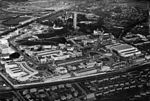Ibrox railway station
Disused railway stations in GlasgowFormer Glasgow and Paisley Joint Railway stationsGovanPages with no open date in Infobox stationRailway stations in Great Britain closed in 1967 ... and 2 more
Railway stations in Great Britain opened in 1871Use British English from June 2017
Ibrox railway station was a railway station in Ibrox, a district of Glasgow, Scotland. The station was originally part of the Glasgow and Paisley Joint Railway.
Excerpt from the Wikipedia article Ibrox railway station (License: CC BY-SA 3.0, Authors).Ibrox railway station
A737, Glasgow Ibrox
Geographical coordinates (GPS) Address Nearby Places Show on map
Geographical coordinates (GPS)
| Latitude | Longitude |
|---|---|
| N 55.8501 ° | E -4.3129 ° |
Address
Paisley Road West / Broomloan Road
A737
G51 2XW Glasgow, Ibrox
Scotland, United Kingdom
Open on Google Maps







